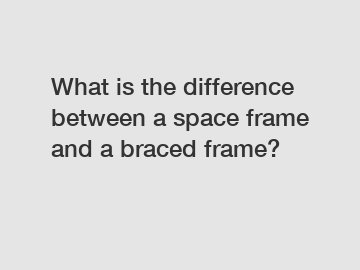What is the difference between a space frame and a braced frame?
What is the difference between a space frame and a braced frame?
Space frame and braced frame are two different structural systems commonly used in construction. The main difference between them lies in their structural behavior and the way they resist loads. Let's dive deeper into their distinctive features and understand the rationale behind their design choices.
Space frames are three-dimensional structures composed of interconnected members, forming a grid-work system. These members, such as beams and columns, are joined together at their ends, creating a stable and lightweight structure. The primary load-resisting mechanism in a space frame is the action of axial forces along the members, which allows for efficient load distribution across the entire structure. Due to their modular design, space frames can span large distances without the need for intermediate supports. This feature offers flexibility in architectural design and allows for the creation of open, column-free spaces.

On the other hand, braced frames are composed of vertical and horizontal bracing elements, which provide stability and resistance against lateral loads. These frames consist of beams, columns, and braces, which are diagonally placed members connecting the columns to resist horizontal forces such as wind or seismic loads. Braced frames derive their strength from the rigidity of the braces, which absorb and transfer forces from the horizontal loads to the vertical members. The braces effectively stiffen the structure and prevent excessive displacement or deformation.
The rationale for choosing a space frame or a braced frame depends on various factors, including the intended use of the structure, architectural requirements, and the geographical location. The primary advantage of space frames is their lightweight nature and ability to span long distances, making them particularly suitable for large-scale structures such as stadiums, exhibition halls, or airport terminals. Additionally, the open and column-free spaces offered by space frames enhance architectural aesthetics and provide flexibility for accommodating various functional requirements.
Braced frames, on the other hand, are commonly used in high-rise buildings and structures that require enhanced resistance against lateral loads. The diagonal bracing elements effectively resist horizontal forces, providing stability and reducing structural deformation during earthquakes or high winds. Braced frames allow for better control over the distribution of forces within the structure, ensuring the safety and integrity of the building, especially in areas prone to seismic activity.
In conclusion, while both space frames and braced frames are structural systems used in construction, they differ in their load-resisting mechanisms and design considerations. Space frames offer lightweight and efficient load distribution for large-span structures, providing architectural flexibility. On the other hand, braced frames prioritize stability and resistance against lateral loads, particularly suitable for high-rise buildings and areas prone to seismic activity. Understanding the distinguishing features and advantages of each system allows architects and engineers to make informed decisions when designing structures that best meet the specific requirements of a project.
The company is the world’s best Dome Skylight Space Frame for sale, Steel Space Frame Structure Warehouse, Toll Station Space Frame supplier. We are your one-stop shop for all needs. Our staff are highly-specialized and will help you find the product you need.

Comments